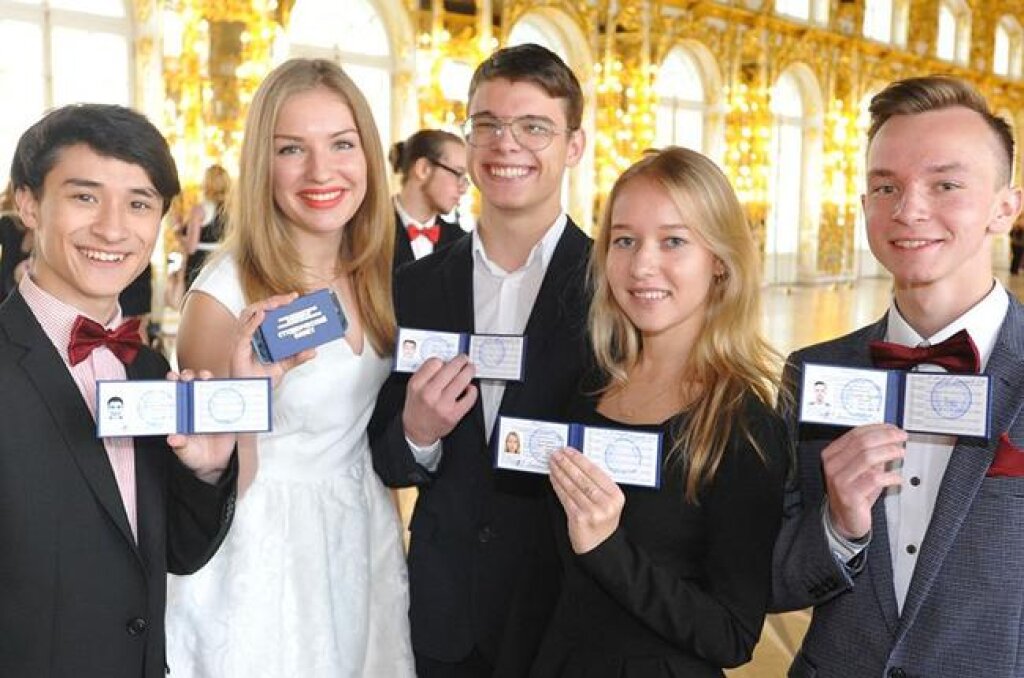Charles Steinwedel's Threads of Empire: Loyalty and Tsarist Authority in Bashkiria, 1552-1917 was published in May 2016 by Indiana University Press.
He is Professor of History at Northeastern Illinois University in Chicago and was a Jordan Center Short Term Fellow in September 2016.
Featured Photo: Bashkir Ruslan Farkheev, far left, and fellow students at the St. Petersburg Humanitarian University of Trade Unions, September 2016.
In September 2016, student Ruslan Varenyi (Farkheev), a Bashkir from the city of Miass in Bashkortostan, disappeared from a poster meant to advertise new students at the “Day of the First Year Student” at St. Petersburg Humanitarian University of Trade Unions. An original photograph showed Ruslan smiling with four other students holding their new student ID cards.
When a poster based on the photograph appeared, however, the image of a smiling, blonde, more stereotypically Slavic-looking young man had replaced that of Ruslan. In the manner Soviet leaders such as Stalin had made political enemies vanish from official portraits, Ruslan had vanished from the university’s poster.
Figure 2 The finished poster announcing the Day of First Year Students. Note that on the far left, a blonder, more Slavic looking young man has replaced Ruslan.
Coming at a time when the Bashneft, the oil company centered in Bashkortostan, was being sold to Rosneft, the university’s act seemed indicative a larger effort to erase Bashkir autonomy. Bashneft had been created after the collapse of the Soviet Union to contain oil assets in the region, the former Bashkir Autonomous Republic, which straddled the southern Ural Mountains about 750 miles east of Moscow. Bashneft’s former head, Vladimir Yevtushenkov, had been placed under house arrest in 2014 after, it seems, he refused to sell Bashneft to Rosneft, Russia’s largest state oil firm. Yevtushenkov had acquired Bashneft from its owner, Bashkir Capital, headed by the son of the former president of Bashkortostan, Murtaza Rakhimov.
Bashneft had been a key source of wealth and power for Rakhimov, who had been the Chairman of the Supreme Soviet of the Bashkir Republic until his election as president in 1993. He had agreed to retire after meeting with then-President Medvedev in July 2010. In October 2016, Rosneft completed the purchase of Bashneft. By integrating Bashkortostan’s major resource into Rosneft and replacing Rakhimov with a man more dependably loyal to Moscow, the Russian Federation had effectively made the economic and political bases for Bashkir autonomy vanish.
This may seem the culmination of a long-term policy by which the Russia state in one form or another sought to minimize or eliminate the primarily Turkic, Islamic Bashkir presence in a Slavic state. The history of Bashkir engagement with the Russian state, however, shows a much more complicated relationship. The Russian state has at times tolerated or even fostered Bashkir collective identity and coherence as a cultural group and at other times sought to destroy them. Land and resources were at the core of such shifts in policy.
Bashkirs and the Russian Empire
Bashkirs first encountered the Russian state after Ivan IV’s conquest of Kazan in 1552. Rather than repeat the vioIence meted out to Kazan, Ivan sent his men among Bashkirs to Kazan’s east and south with a charter stating that Bashkirs had no need to flee. “Let everyone preserve his faith [and] observe his customs.” In exchange for paying tribute to the tsar, Bashkirs were largely left alone to graze their livestock on Bashkiria’s vast steppe. The semi-nomadic Bashkirs typically wintered in villages but in the spring drove their herds north into the hills to avoid hot summers on the steppe.
Over the next 180 years, this situation persisted. Periodically Bashkirs perceived the Russian state to have violated the understandings that underlay their relationship, and took to arms. After sometimes fierce fighting, the “rebels” and the state would come to terms, and Bashkirs again would swear allegiance to the tsar. At a time when other rural groups became enserfed, Bashkirs were not. They remained collective owners of their land, which drew those not ethnically Bashkir into the Bashkir estate.
This changed dramatically in 1735. When Peter’s protégés sought to make good on Peter’s vision of a land empire in Asia by creating the city of Orenburg in 1735, this seemed to Bashkirs to violate the essence of their relationship. Bashkirs took to arms again. Now, however, Petrine concepts of absolutism permitted no negotiations. Bashkirs had to accept the tsar’s authority unconditionally. The resulting conflict lasted five years and is estimated to have cost Bashkirs thousands of casualties—as many as one-fifth of the population. The Bashkir population did not fully recover from the losses until the end of the century. In the decades that followed, the state promoted construction of factories that ate into Bashkir landholding and introduced governance to the region in ways unprecedented before 1735. Bashkirs fought such encroachments in 1755 and Bashkirs made up a substantial component of Emelian Pugachev’s forces in the uprising of 1773-1775.
Bashkirs and Imperial Reforms
After Pugachev’s defeat, however, Catherine the Great presided over a very different set of policies. In 1788, her man in Bashkiria, Baron Osip Igel’strom, created the Orenburg Muhammad Ecclesiastical Assembly (OMEA) headed by a mufti to administer Muslim affairs. Igel’strom also started to organize Bashkirs into cantonal administration, a Cossack-like form in which Bashkir communities provided and equipped soldiers for the tsar’s army rather than pay taxes.
Within this system, Bashkirs served with distinction in the campaigns against Napoleon. Bashkir canton heads enjoyed status locally and took advantage of it to make a place for themselves in the empire’s administrative hierarchy. By 1850, Bashkirs still owned much more land than other peoples locally, which made it relatively good to be a Bashkir again. Bashkir canton heads enriched themselves by building potash factories and grist mills.
Cantonal administration and the OMEA, and the presence of noble landowning, integrated Bashkirs into the empire sufficiently to make it possible to apply the Great Reforms to Bashkiria, which made Bashkirs more like peasants than they had been before. Now Bashkirs could sell their collective landholdings, serve in zemstvos, and, in 1874, serve in the empire’s military alongside Slavs.
A combination of market forces, official corruption, and in-migration then undermined Bashkirs economically. Since semi-nomadic pastoralism had grown difficult on reduced landholdings, many Bashkirs sold their land at ridiculously low prices or were essentially swindled out of it by a combination of alcohol, trickery, and force. Local officials took advantage of efforts to survey Bashkir land to redistribute it to their friends and local allies.
By the 1890s, Bashkirs struggled to practice pastoralism, yet took to new farming techniques slowly. They became impoverished and their numbers dwindled. The Bashkir land scandal resulted in Bashkirs’ dispossession, dislocation, and poverty. Leo Tolstoy made the land grab an example of self-destructive greed in “How Much Land Does a Man Need?” By 1898, the governor of Ufa province, at the core of Bashkiria, became concerned that Bashkirs were literally vanishing, or “dying out.”
In the first decades of the twentieth century, as Bashkirs became ground down economically Bashkir elites made the case for Bashkirs as a nationality based on language and culture, but also on their nomadic past, landownership, history of rebellion, and military service. A few Bashkirs served in the State Dumas after 1905, where they and their allies who represented the region made the case for Bashkir loyalty to the Empire and Bashkir rights to their land.
After the October Revolution of 1917, Bashkirs under the leadership of Zeki Validi Togan declared Bashkir autonomy, claiming the right to their lands. Bashkir leaders eventually compromised with Soviet authorities who declared the Bashkir Autonomous Republic in March 1919—the first such constituent of Soviet Russia. Tensions with central authorities turned Bashkir leaders against Moscow and caused them to flee to the Ural Mountains or Central Asia in June 1920.
The first quarter century of Soviet Power was extremely difficult for Bashkirs. Since the Bashkir leadership had initially sided with the Whites in the Civil War, many Russians fighting for the Bolsheviks saw them as political enemies. After Ufa changed hands four times in the Civil War, 1917-1921, the Red Army and local Bolsheviks turned on Bashkirs, arresting, beating, or even killing those who surrendered or were captured. In the early 1920s, there were few Bashkirs among the local elite. Collectivization hit the Bashkir Autonomous Republic hard in the late 1920s and early 1930s.Soon after collectivization, a few hundred thousand people of all Bashkiria’s nationalities vanished in the purges.
At the same time, though, Soviet power supported a particular type of Bashkir culture as tsarist officials had never done. A Bashkir press and book publishing emerged, the site of an Orthodox church in the center of Ufa became the Bashkir Dramatic Theater, and Bashkirs could see Bashkir plays and dance celebrated. Bashkirs headed most local institutions.
Bashkir Autonomy becomes Sovereignty—for a while.
On October 11, 1990, the Bashkir Autonomous Republic’s political leaders declared the republic’s sovereignty. The way in which they did shows the continuing power of the idea of the Bashkirs as owners of the land they possessed when some first swore allegiance to the Muscovite tsar. They asserted their rights to resources under that land. According to the declaration, sovereignty would allow Bashkortostan’s population “to be masters of our own land, to end the lack of control, the barbaric exploitation of our natural riches, the pollution of our water and air, to direct all economic and spiritual potential toward the more full satisfaction of the most immediate needs and requirements of the people.”
Bashkir leaders made no attempt to become independent of the Russian Federation in the manner Chechens had. The emphasis in Bashkortostan was on the control of resources. For the first decade of Rakhimov’s governance of Bashkortostan, he managed to create a political machine that did just that. He kept Bashkortostan’s resources in the control of Bashkirs in general, and of his own family and associates in particular. Since Bashkirs comprised only 22 percent of the republic’s population, substantial manipulation was necessary to ensure Bashkir dominance of regional institutions in the context of mass politics.
After 2003, Moscow weakened Rakhimov’s political control. He was no longer able to use electoral commission to keep unwanted challengers off the ballot and to observe laws at odds with those of the Russian Federation, such as a requirement that office holders speak Bashkir. Russia’s large, often state-owned companies that Rakhimov had been able to keep at bay, now entered the region and reshaped its economy. Bashkortostan has become part of a “single legal space” under the authority of Vladimir Putin.
In the long view of Bashkir engagement with a Russian state, the recent integration of Bashkortostan into the Russian state has been handled much more deftly and much less destructively than efforts in previous eras: the large scale violence in the 1730s; market forces, official corruption, and dispossession in the 1870s; and collectivization and purges of the Soviet era. Bashkirs and Bashkir culture will be much more difficult to make disappear than removing a student from a university poster. How Bashkirs endure the intense Russian nationalism characteristic of the last decade--of which the university’s action is only a small indicator--remains to be seen.




